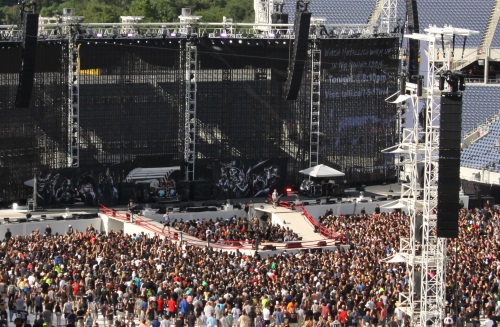
Gain Taper Risks Vs Benefits
There are tangible risks to offsetting levels and EQ within a coupled loudspeaker array. Gentle slopes and gradual level transitions will reduce the risk, while steep slopes and transitions will increase it.
There’s potential for phase offset between elements that have different EQ curves, but this should be minimal as long as reasonable EQ is applied.
It’s the impact on dynamic range that merits detailed discussion. Asymmetric EQ and level taper will reduce the dynamic range and potentially cause dynamic shifting, i.e., some parts of the system may reach limiting before others.
This can be a classic TANSTAAFL (There ain’t no such thing as a free lunch) trade-off between maximum uniformity, stability, and headroom. Detectible instability in the frequency and spatial response are unacceptable outcomes. In short, dynamic uniformity is a vital part of level and spatial uniformity.
Level taper affects on dynamic range (Figure 2) can be used as a reference point. This is one area where the program material and usage are extremely relevant. If the system is to be operated at its absolute maximum at all times (e.g., a heavy metal music festival), then front/back level uniformity must yield to maximum dynamic range and stability (level tapering and asymmetric EQ must be absolutely minimized).
By contrast, if the system will be operated with ample headroom under controlled conditions (e.g., musical theater), then asymmetric EQ and level tapering become viable options to maximize uniformity. This decision must be evaluated in the field based on risk and return.
My personal approach is generally to compromise, using minimal asymmetric EQ and leveling to reduce, but not necessarily fully eliminate the level increase in the front of the room. Risks are relatively low if the asymmetry can be kept low through a large majority of the array. Increased asymmetry at the bottom has more potential benefit and is less likely to cause audible instability to the majority shareholders above them.
Bear in mind, however, that much of my work is in applications that highly prioritize uniformity and fidelity, which leaves me with more room for asymmetry than those who optimize systems that absolutely must prioritize for maximum stability while delivering bone-crushing power.
Real-world loudspeakers will have variable amounts of overlap over frequency. An array of constant beamwidth models will have an upper range with constant overlap and a lower range with increasing (and variable) overlap. The effectiveness of asymmetric EQ techniques therefore varies over frequency, with the HF range enjoying the lowest side affects and risks.
An array of proportional beamwidth models has proportional overlap, i.e., it rises gradually and steadily with wavelength. Combined EQ can be approached here by segmenting the spectral range into isolated (HF) and overlapped (LF) regions. EQ and level setting for the isolated HF is carried out by the ABC approach (separate EQ for A, B and C as soloists followed by a mutual EQ to compensate for the combined effects).
By contrast, the LF region is approached as a single block, with all EQ and level settings matched (i.e., symmetric). This approach will likely yield less uniformity than the fully asymmetric approach but eliminates the dynamic risks inherent in asymmetric EQ.
We all strive for front/back level uniformity, yet many fear the perils of breaking the line. There’s a limit to how much we can squeeze these systems by splay angle asymmetry alone. The cluster is hung and isn’t coming back down, so we need to look at how much level disparity is still left. If it’s too loud in front, I vote we break the line and turn down the lower boxes, until or unless we know we are reaching the point of dynamic instability. If you have a better measurable and verifiable method, I’d love to hear it.
Theory World
One funny historical aspect related to this subject: 30 years ago when we started utilizing FFT analyzers to tune sound systems, many engineers would deride us. They resisted our use of an analyzer to help make decisions, saying we lived in “theory world” and that they lived in the “real world.”
Nowadays some engineers still want to limit the actions we perform based on the analyzer, but the problem has been flipped on it’s head: we’re the ones living in the real world and they’re living in theory world. Funny that one, eh?

